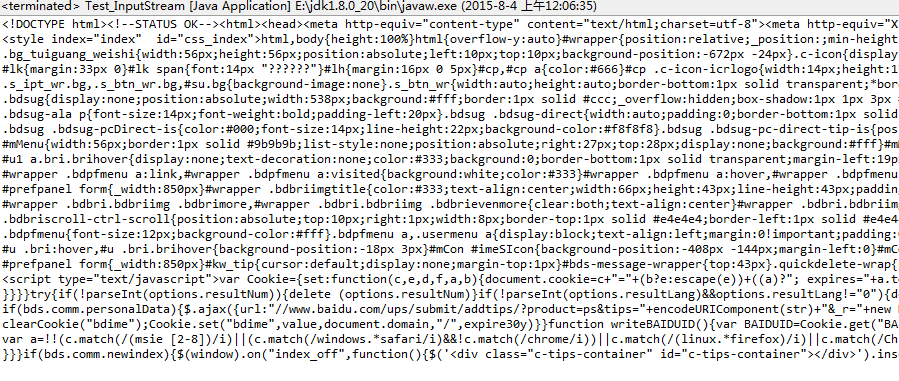https://blog.csdn.net/zgljl2012/article/details/47267609
在Java中,上述三个类经常用于处理数据流,下面介绍一下三个类的不同之处以及各自的用法。
- InputStream : 是所有字节输入流的超类,一般使用它的子类:FileInputStream等,它能输出字节流;
- InputStreamReader : 是字节流与字符流之间的桥梁,能将字节流输出为字符流,并且能为字节流指定字符集,可输出一个个的字符;
- BufferedReader : 提供通用的缓冲方式文本读取,readLine读取一个文本行, 从字符输入流中读取文本,缓冲各个字符,从而提供字符、数组和行的高效读取。
下面有三个Demo(Demo访问百度主页获取字节流然后输出)来分别说明三个类的作用:
- InputStream
package 数据流;
import java.io.IOException;
import java.io.InputStream;
import java.net.MalformedURLException;
import java.net.URL;
public class Test_InputStream {
/**
* 获取字节流
* @param url
* @return
*/
private String getStream(String url){
//获取字节流
InputStream in = null;
String result = "";
try {
in = new URL(url).openStream();
int tmp;
while((tmp = in.read()) != -1){
result += (char)tmp;
}
} catch (MalformedURLException e) {
// TODO Auto-generated catch block
e.printStackTrace();
} catch (IOException e) {
// TODO Auto-generated catch block
e.printStackTrace();
}
//输出字节流
return result;
}
public static void main(String[] args){
String URL = "http://www.baidu.com";
Test_InputStream test = new Test_InputStream();
System.out.println(test.getStream(URL));
}
}
- 1
- 2
- 3
- 4
- 5
- 6
- 7
- 8
- 9
- 10
- 11
- 12
- 13
- 14
- 15
- 16
- 17
- 18
- 19
- 20
- 21
- 22
- 23
- 24
- 25
- 26
- 27
- 28
- 29
- 30
- 31
- 32
- 33
- 34
- 35
- 36
- 37
- 38
- 39
- 40
- 41
- 42
- 43
- 44
通过URL连接获取了InputStream流连接,然后通过read方法来一个字节一个字节的读取字节流并组合在一起(read方法返回-1则数据读取结束),最后以reasults返回。
输出如下:
60 33 68 79 67 84 89 80 69 32 104 116 109 108 62 60 33 45 45 83 84 65 84 ……
这就是字节流,每个数字都是一个字节(Byte,8位),所以如果读取英文的话,用字节流,然后用(char)强制转化一下就行了,但如果有中文等双字节语言或者说需要指定字符编码集的情况,就必须用到InputStreamReader将字节流转化为字符流了。
- InputStreamReader
package 数据流;
import java.io.IOException;
import java.io.InputStream;
import java.io.InputStreamReader;
import java.net.MalformedURLException;
import java.net.URL;
public class Test_InputStreamReader {
/*
* 得到字符流前需先有字节流
*/
private String getStream(String url){
try {
//得到字节流
InputStream in = new URL(url).openStream();
//将字节流转化成字符流,并指定字符集
InputStreamReader isr = new InputStreamReader(in,"UTF-8");
String results = "";
int tmp;
while((tmp = isr.read()) != -1){
results += (char)tmp;
}
return results;
} catch (MalformedURLException e) {
// TODO Auto-generated catch block
e.printStackTrace();
} catch (IOException e) {
// TODO Auto-generated catch block
e.printStackTrace();
}
return null;
}
/**
* @param args
*/
public static void main(String[] args) {
// TODO Auto-generated method stub
String URL = "http://www.baidu.com";
Test_InputStreamReader test = new Test_InputStreamReader();
System.out.println(test.getStream(URL));
}
}
- 1
- 2
- 3
- 4
- 5
- 6
- 7
- 8
- 9
- 10
- 11
- 12
- 13
- 14
- 15
- 16
- 17
- 18
- 19
- 20
- 21
- 22
- 23
- 24
- 25
- 26
- 27
- 28
- 29
- 30
- 31
- 32
- 33
- 34
- 35
- 36
- 37
- 38
- 39
- 40
- 41
- 42
- 43
- 44
- 45
- 46
- 47
- 48
先获取字节流,然后创建InputStreamReader将字节流转化成字符流,并指定其字符集为UTF-8,然后使用强制转化将read到的int字节转化为char型,此时已可以输出中文字符,并且可速度上看出,输出字符流比输出字节流要快。下面是结果的部分截图:
- BufferedReader
package 数据流;
import java.io.BufferedReader;
import java.io.IOException;
import java.io.InputStream;
import java.io.InputStreamReader;
import java.net.MalformedURLException;
import java.net.URL;
public class Test_BufferedReader {
/*
* 字节流——字符流——缓存输出的字符流
*/
private String getStream(String url){
try {
//得到字节流
InputStream in = new URL(url).openStream();
//将字节流转化成字符流,并指定字符集
InputStreamReader isr = new InputStreamReader(in,"UTF-8");
//将字符流以缓存的形式一行一行输出
BufferedReader bf = new BufferedReader(isr);
String results = "";
String newLine = "";
while((newLine = bf.readLine()) != null){
results += newLine+"
";
}
return results;
} catch (MalformedURLException e) {
// TODO Auto-generated catch block
e.printStackTrace();
} catch (IOException e) {
// TODO Auto-generated catch block
e.printStackTrace();
}
return null;
}
/**
* @param args
*/
public static void main(String[] args) {
// TODO Auto-generated method stub
String URL = "http://www.baidu.com";
Test_BufferedReader test = new Test_BufferedReader();
System.out.println(test.getStream(URL));
}
}
- 1
- 2
- 3
- 4
- 5
- 6
- 7
- 8
- 9
- 10
- 11
- 12
- 13
- 14
- 15
- 16
- 17
- 18
- 19
- 20
- 21
- 22
- 23
- 24
- 25
- 26
- 27
- 28
- 29
- 30
- 31
- 32
- 33
- 34
- 35
- 36
- 37
- 38
- 39
- 40
- 41
- 42
- 43
- 44
- 45
- 46
- 47
- 48
- 49
- 50
- 51
获取字符流后,可直接缓存,然后从缓存区取出,这时的速度比InputStreamReader又将快上很多。输出结果同上。
- 总结
在读取网络数据流的时候,可以通过先用InputStream获取字节流、InputStreamReader将字节流转化成字符流、BufferedReader将字符流以缓存形式输出的方式来快速获取网络数据流。
